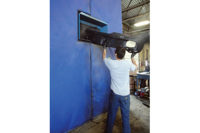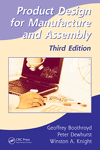If noise reduction is a goal in your designs, the right incorporation of perforated metals can sometimes help achieve that. Here’s some helpful design tips on how to do that.
Noise reduction is an increasingly important challenge for appliance designers, as OEMs seek to meet rising consumer demands for quieter, less intrusive products for their homes. Perforated metals, which fulfill various functions in an array of appliances, are particularly useful in this acoustical context. One reason is that they, unlike other common components of sound absorptive treatments, can be cleaned or refinished without harming the absorptive properties for which they were designed.
Determining Your Noise Issue
The first step toward successful use of perforated metals for an acoustical application is to get a better handle on the nature of the noise produced by your appliance design. You can reach some general conclusions simply by listening carefully. If you hear a pure tone or a prominent frequency (a squeal, hum or whine, as opposed to a whoosh or roar, like a waterfall), this is a good indication that the disturbing noise is concentrated in a limited frequency range.
However, a more detailed frequency analysis, whether measured or estimated, will show more clearly how the energy of the noise is distributed among the various frequencies. The most accurate means of determining how the energy is distributed over different frequency bands is by means of a sound level meter.
Figure 1 shows that the noise of a typical stove hood is strongest at low frequencies (125 and 250 Hz), while that of an electric drill is most intense at high frequencies (2000 and 4000 Hz). Dehumidifier noise is distributed about equally over the entire frequency range.
In performing your noise analysis, it’s important to account for the full range of operating conditions of the appliance and related work materials. A change of operating speed or work material can significantly affect the noise energy distribution. Also, you should allow for a possible change in the dominant noise frequency as the equipment ages and wears.
If your problem is a broad-band noise issue, such as with the dehumidifier, you’ll need to take a different approach from the one you’ll need to take with a narrow-band noises of the range hood and the electric drill. Sometimes a perforated metal will need to be completely transparent to the sound, other times you’ll need it to be tuned to the problem frequencies. Let’s explore these two approaches further.
The Sound Transparency Approach
In this instance, perforated metal acts as a protective or decorative covering for some special acoustical material, which is designed either to absorb sound or to reflect or scatter sound in a specific way. The material underneath does the actual noise control, so the purpose of the perforated metal in such applications is to “disappear” acoustically: that is, it must be so transparent that the sound waves can pass right through it. The design goal in this case is to choose the perforated metal that allows the greatest sound transparency for sounds of all frequencies.
So what’s the best perforated metal design for this application? Most people assume that the greater the percent open area of the sheet, the more easily sound can go through it. And generally speaking, this assumption is correct, but not always. For example, we could make a sheet with 10 percent open area in two ways: either by making a single large hole at the center, or by very fine perforations overall. In Figure 2, both sheets have a total open area of 10 percent. But in the one on the left, 90 percent of the material is completely opaque to sound—reflecting it rather than letting it pass through. Meanwhile, the material on the right is nearly 100 percent transparent to sound.
For high transparency, the most important consideration is to have many small perforations, closely spaced. It is better to minimize the bar size (the size of the solid portions between the perforations) and (to a lesser extent) to minimize the sheet thickness, rather than to concentrate on percent open area. However, for practical reasons, very tiny holes should be avoided because they may get clogged with dust or filled with paint when the sheet is repainted. Perhaps more important, very finely perforated sheets tend to be fragile and are much more expensive to manufacture.
Therefore it is sometimes best to choose the gage of the metal first, based on cost, availability or other reasons, then choose the possible hole size, and jockey the other parameters to achieve the desired transparency.
The Tuned Resonance Approach
In some applications, you may need to absorb sound only in a certain band of frequencies, but not at frequencies lying above and below that band. The practical advantage is that focusing the frequency of the problem noise enables the actual absorptive material to perform its function more efficiently and with much less material.
For this purpose, you need a resonant sound absorber. In this application, the perforated metal, instead of disappearing, takes an active part in tuning the absorber—that is, in determining which frequencies of sound are absorbed. In this application, the perforated metal is used in combination with a trapped layer of air to modify the acoustical performance of the absorptive material by concentrating the sound absorption into a particular frequency range.
Here’s how it works: The air particles oscillate in and out of the holes in the metal sheet in response to an incident sound wave. The preferred frequency of this oscillation is determined by the mass of the air in the perforations and the springiness of the trapped air layer.
At that resonance frequency, the air moves violently in and out of the holes and the adjacent sound absorptive layer. There, the acoustic energy (carried by the back-and-forth motion of the air particles) is converted by friction into heat and is thereby removed from the acoustical scene. You can tune the absorption characteristics via your choice for the absorptive material in the cavity and where you locate that material in the cavity.
What’s the Best Material and Design for Your Application?
Many different materials are suitable for perforation in the acoustical context. Aluminum and stainless steel are the most common choices, followed by inconel or titanium alloys. All of these materials retain excellent strength even in minimum thicknesses and with perforation.
You also have many options for hole shape, pattern and size. Round holes in staggered patterns—which provide greater structural strength—are the most common choice overall. However, square holes are frequently used in appliance designs, although this shape usually functions as a guard or a grill and not as an acoustical component.
Regarding hole size, as mentioned previously, you generally want to strive for smaller holes in noise control applications. However, as a rule, hole diameter should never be less than the thickness of the material.
More broadly speaking, the shape of the metal sheet itself has an impact. In acoustical applications, the metal is often bent or corrugated as opposed to flat. These varied shapes not only lend visual interest, they can also serve to further deflect or otherwise manage noise.
Getting Your Perforation Project Right
Ultimately, your ideal design will depend on the noise control need and the specific frequencies involved. Noise reduction is a specialized discipline, so partnering with a skilled noise engineer is essential in narrowing your choices to those that best match your application. Testing materials prior to production will help ensure your success. A series of calculations can help you pinpoint the effective sound transparency and absorption efficiency of an acoustical material covered with perforated metal sheet.
In addition to acoustical concerns, appliance designs must balance a variety of other key goals, including proper ventilation. Fortunately, the incorporation of perforated metals can often support these objectives. But to do so effectively, you’ll need to access the expertise and experience of a proven industrial perforator.















